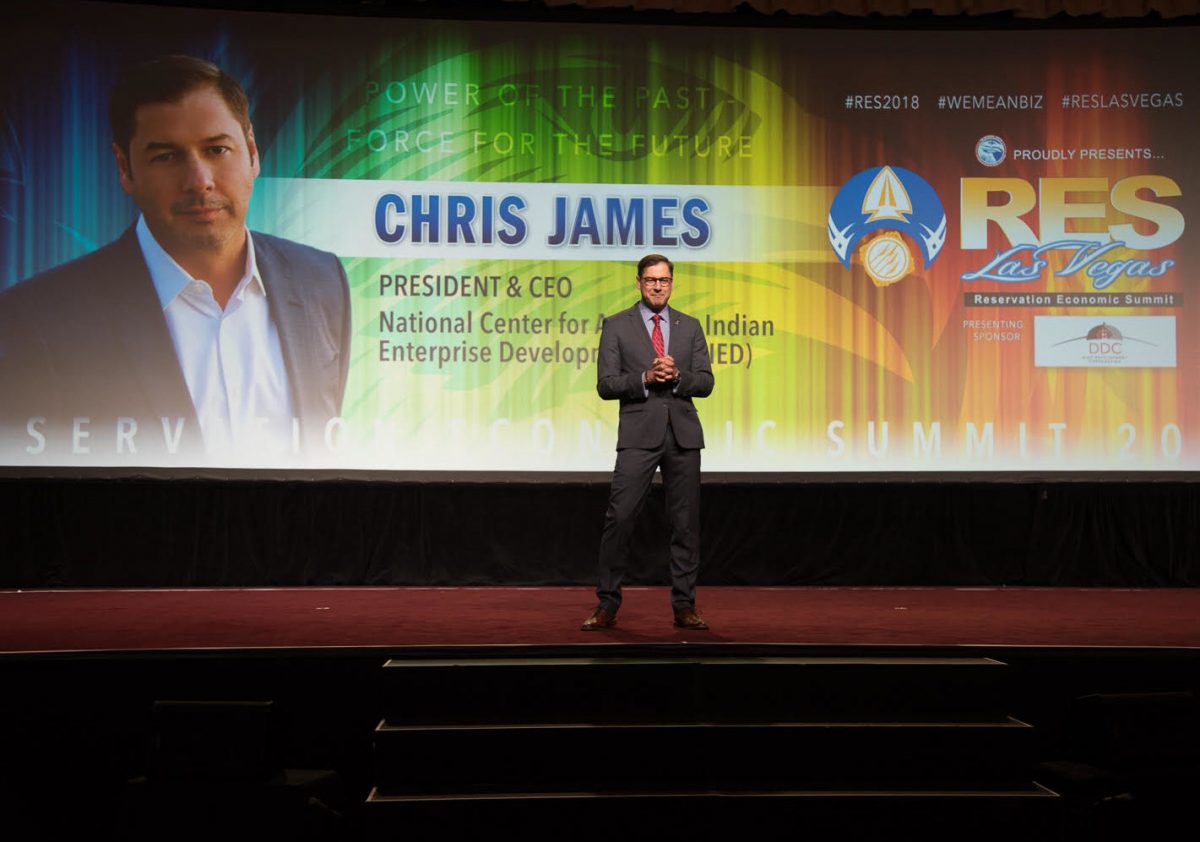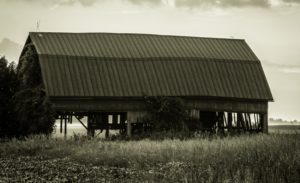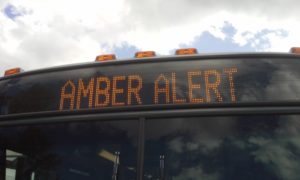
Native Edge: Why Protecting Your Tribal Business Is Protecting Your Tribe In A World Without Borders
Above: Chris James addresses the Reservation Economic Summit (RES) in Las Vegas in March 2018; photo courtesy NCAIED.
Note: This is the first in a series of “Conversations across Communities,” which will touch upon various aspects of security, surveillance, law enforcement, intelligence, crime, criminal behavior, law, investigations, regulation, technology, demographics, data, incarceration, and the effect and confluence of business, government and policy on these. It features the people and communities affected by changes across these areas. One conversation will be highlighted every month in Biometrica’s new monthly newsletter, starting Wednesday, May 2, 2018. Biometrica’s blog will host these conversations and other pieces every Tuesday. You can sign up here for the newsletter.
By Kadambari M. Wade
From frauds and scams to cyber-attacks and terror attacks in both the real world and the virtual, threats to businesses and communities are varied and real. For Native American communities, where businesses, government, transportation and socio-cultural systems are intrinsically linked, the threat is even greater for two reasons: First, because various parts of the whole are inherently connected, what affects one part will affect another in general. And second, because, as Chris James, the President & CEO of NCAIED, the National Center for American Indian Enterprise Development, puts it, “If I’m a tribal business and I lose PII data, often times, it isn’t just my head or my business on the line. In the case of many tribes, it’s my community on the line. Depending on the scope of the loss and when you knew and what you allowed to happen, it could well be a criminal act that affects the community.”
As head of NCAIED, James’s work is directly focused on assisting American Indian and Alaska Native communities and their enterprises with business and economic development, and on empowering individuals within those communities. However, as someone who grew up in rural western North Carolina on the Cherokee Indian Reservation or Qualla Boundary, he is passionate about the importance of having access to resources and technology. In an IOT-driven world, he also feels it’s crucial for tribal governments and businesses to recognize economic development also includes the importance of protecting their assets in the real world and the virtual, on a continued basis across physical and virtual environments.
From The Native Edge Institutes, to resource scarcity when dealing with security issues, to dealing with the economic effects of generations of historical trauma, to hope from a revitalized youth, we spoke to James on a variety of issues affecting Tribes today.
Interviewer: About two years ago, we spoke with Andrew Hofstetter, the head of the Tribal Gaming Protection Network, on why the TGPN existed [See that interview here]. He had said there was a “real need to educate tribes as to red flags, and what tribes could do to protect themselves.” One of the major issues he spoke about when it came to protecting a property or business from liability, across a variety of topics, from frauds and scams, to active shooter situations, to OSHA compliance and cybersecurity, was the lack of resources available to dedicate to protection. How do you tackle something like this in your conversations on asset protection, which is an integral part of developing a business or enterprise?

Chris James: Our focus, in all our activity, is on business and economic development, and some of those challenges include working with some of the things you’ve mentioned, specifically in the context of fraud, safety, security, cybersecurity, data-sharing and privacy. Some of the challenges our communities have, or any small business has, really, is that technology is moving so fast, or changing so fast, that it becomes very challenging to come to grips with it. It’s really hard on the small business owner or tribal manager or tribal official every time there’s a new malware attack and something new crops up — resources are scarce, and you feel constantly overwhelmed; by the time you’re protected in one area, something else crops up. The spate of ransomware attacks of late has been worrying, to my knowledge, a major attack on a tribal community so far has not happened, but everyone is vulnerable.
I think a couple of tribal casinos were hit, actually, and PII information has been lost, but nothing on a mass scale that we know of as yet. Do you think that’s more because they haven’t really been identified as a potential target? And it’s a larger problem if they are, because of the links within communities.
Yes, often times the issue is that a cyber-attack on a tribe would be an attack not just on a business sector but also an attack on a tribal government, if you hit one, you could hit the whole network, and that is a major problem.
There’s often a relationship between the business and the socio-political community at large?
Absolutely. A tribal business, more often than not, works for the betterment of its members and the tribe as a whole. A lot of times, their businesses are under an umbrella, it could be a Section 17 umbrella, where it’s owned by the tribe but is distinct from the tribal government. It could be a business that’s an 8(a), or manufacturing, while a second piece could be a gaming facility. Regardless of the size of the business itself, it may have a bingo hall, for instance [as the gaming facility], it still falls under that umbrella of enterprise development.
There’s no separation?
As always, it all depends on the community but yes, in many cases, there’s little separation.
So an attack on one part of a tribal network may be an attack on all its parts. It really depends on the community…
Yes, exactly, and that’s one of the things we’re hoping will be more evident at our cybersecurity, security and data-sharing presentations during late summer’s upcoming Native Edge Institute.
This conversation about every part of the whole often affecting the other brings us to something else we wanted to bring up, an article we’ve also referred to in past pieces. It’s not directly linked, but it is linked to the whole of what we’re discussing when it comes to factors affecting both economic development and security of tribal communities. A 2015 article in a five-part Al Jazeera America project on Native American gangs stated: “The growing threat of Native gangs is not a retelling of cowboys and Indians set against the backdrop of a modern black market. It’s a story about how historical trauma, federal policy and tribal pride have created a new Indian problem: Organized crime.”
The project referred to two telling statistics: Data from 2007, which showed that less than half of Native Americans aged 25 and over had a college or graduate degree. And a 2014 Aspen Institute report that asserted that Native American teens experience the highest suicide rate of any population group in the United States.
These facts, coupled with rising drug use across America, not just on tribal lands, have led to a renewed resolve to tackle a not-so-new problem that is also quickly reaching epidemic proportions in Indian country: Human Trafficking. An article in Indian Country Today on Aug. 1, 2016, reported that a Northeastern State University study on methamphetamine use in tribal communities, found several disturbing trends. This is from that: “Organized criminal gangs are targeting casinos in tribal jurisdictions to facilitate drug sales and sex trafficking, and drugs are being trafficked by large non-Native organizations with international ties…”
Given the above context — here’s the question. How do you look at working with the community at large at understanding and tackling issues like these: A lack of employment, a rise in drug use and drug sales, a rise in sex and human trafficking and organized gang activity on reservations, and a lack of resources, all of which are known factors that hamper economic development and enterprise development, both of which are core tenets of what you are tasked to do at NCAIED.

Let me try and break this all down. The first piece, from my perspective, is the Indian Country Today article. Unemployment on American Indian reservations has historically been extremely high. This is a persistent challenge and one that is the focus for the National Center for American Indian Enterprise Development and many other organizations. Unemployment means poverty, in most cases, despair, high suicide rates, dropout rates, poor health, poor housing conditions. These conditions are created by chronic unemployment, and the persistence of these issues creates an almost never-ending cycle of poverty. We must break it.
A majority of our tribal community today is rural, living in areas that are largely rural. If you look at rural America as a whole today, it is facing some of the same issues that are facing our tribal communities — it is well documented that some of the poorest places in the country are in rural counties that have been affected by factories closing, automation replacing labor in facilities and farms, a rampant opioid crisis, and young people without degrees or jobs. So I think some of the issues you mention aren’t just a tribal problem, they’re an American problem.
In some ways, reservations face the same economic challenges as rural areas in general. No access to big markets, lack of high-speed internet, geographic isolation, limited educational and other training opportunities, little access to capital or other forms of outside investment. These factors are often realities in rural areas. They are amplified on reservations.
What is the solution?
There are lots of solutions. Technology is one example; communities working together to use social media — which they are doing increasingly — is another. Just recently, after working together for two years in the wake of the tragic murder of a child, the Navajo Nation implemented its own Amber Alert system. It can reach 11 counties across Arizona, Utah and New Mexico in real time when a child goes missing. Previously, the response time might have been up to 24 hours or so, and that is a terrifying thought, not just from the perspective of a father, but also from the perspective of someone that has grown up in a rural area — in my case, Cherokee, North Carolina, about 60 miles west of Asheville — I’m well aware of how isolated it can be, and how far away help can be.
Often, it wasn’t just that a reservation was rural, but also that the county itself was rural. And that’s where I think technology can play a big part, whether it’s the Amber Alert, whether it’s other technology like what you guys do at Biometrica, or many examples of where community change comes from social media, from things like Facebook, and Twitter, where the response isn’t necessarily from government or external forces but from citizens. Now there are apps, community apps where we can connect, where we can help each other in real time. Looking at some of the issues of human trafficking, influence of gangs and drugs, etc., we’ve got to involve communities too.
We’ve talked about resistance to change. I get that. But I don’t get the resistance to life-saving technology. Whether it’s an Amber Alert, or something that gives you real-time alerts on pedophiles, or helps you augment your depleted police force with technological resources, or something that can help you protect your child, or track what your child is using, why the resistance to that? Why is that even up for debate?

Unfortunately, I don’t have an answer to that. That might just be the cost of a system. In the case of some tribal communities, it could be access to grants, or financial support. A second system may just be a need to find a way to get across an understanding of the benefits of using a particular technology. With some communities, it helps seeing the example in another community. If one community, like the Navajo with the Amber Alert, of a similar size, capacity and rural-ness, begins adopting a particular technology successfully, then another one is likely to follow suit with adopting that technology or others.
It’s really important to keep in mind also that these are sovereign nations. Each is governed separately. Each is proudly independent. Just because something will work in New York City does not mean something will work or can be replicated on a rural reservation. When we created Startup in a Day at the Small Business Administration, and focused on working with communities, including tribal communities, to make it easier for businesses to apply for licenses and permits to launch a business in a day, we found that in the major cities, it was easier to identify roadblocks and find solutions quickly. However, as you went further out, beyond the major big cities and centers, it became harder to find support structures, harder to get them to open up their books and find what the roadblocks to entrepreneurship were, what the barriers to change were, what workable solutions could be found. It’s similar, isn’t it? On or off a reservation — changing minds isn’t always easy.
How difficult is information sharing from a security perspective, between different businesses and sovereign nations?
I think it’s a challenge but not just because of the business or sovereign nation part. I think it’s also a resource issue. In a lot of areas, the newspaper is still the No. 1 avenue to get information out. Back home in Cherokee, North Carolina, you still have the Cherokee One Feather as a once-a-week print publication as the mainstay, part of a tribal program, but you now also have an online version. In my community, an online connection is fairly easy, but in other communities, it’s very hard. You still have dial-up connections, and no fast access to broadband. You can get access to a daily newspaper but it’s very hard to have access to commerce and business on dial-up, or connectivity to social networks, or real-time security updates.
From a security perspective, data in this world we’re in and the world we’ll be in, increasingly, is everything. If you don’t have data and information sharing, how do you monitor the good from the not so good? Surveillance is given a bad name and called Orwellian, but if you don’t look out for bad actors or threats, in a world where you have malware, or active shooter situations, and have communities where you don’t have enough cops, what’s the alternative to tech and data sharing?

There isn’t really one and it is a challenge. But it’s a challenge not just for tribal communities and businesses; data sharing is a challenge right up to the federal level. Look at DC, and the chaos that often exists between various branches of agencies of the government there. It continues to be a challenge. That is also true of rural communities, and information sharing across city, town, county, reservation and state lines. I think it’s a process, and we’re going to have to eventually look at adopting technologies that allow us to securely share data that protect our assets, human and otherwise, and provide access to information-sharing networks. But it’s not going to be overnight.
Depending on whether you’re a criminologist or an economist, your theory of the relationship between crime rates and economic conditions may differ. However, there’s no question that no community can prosper, economically or otherwise, if its women are being victimized. According to “The Devastating Impact of Human Trafficking of Native Women on Indian Reservations,” a transcript of the 2013 testimony of Lisa Brunner, of the National Indigenous Women’s Resource Center, to the U.S. Senate, “Native women experience violent victimization at a higher rate than any other [segment of the] U.S. population.”
It also stated: “Congressional findings are that Native American and Alaska Native women are raped [at the rate of] 34.1% — more than one in three will be raped in their lifetime; 64%, more than six in 10, will be physically assaulted. Native women are stalked [at] more than twice the rate of other women. Native women are murdered at more than 10 times the national average. Non-Indians commit 88% of violent crimes against Native women.” Brunner’s testimony was deeply disturbing. It also spoke of the predatory economics of “undocumented man-camps” after the fracking boom in North Dakota and Montana, which led, in turn, to a documented increase in multi-faceted criminal incidents.
The reason I mention this is while the economic and environmental impact of fracking gets a lot of play, the negative impact of certain economic “events” on American Indian women, by non-Native men, is not talked about as much as it should be. From an economic perspective, a business organization perspective, and the fact that in in the tribal world, you cannot always separate your business organizations from your community organizations, how do you protect each part of the whole, from an enterprise perspective, in order to protect the whole?

There are two things here. In 2013, President Obama signed the reauthorized and strengthened Violence Against Women Act. About two years after it was signed, one of the updated provisions allowed us, as a community, to reach a monumental milestone. For the first time, a non-Native man who abused a Native woman on a reservation or tribal land could be investigated by tribal law enforcement and tried by tribal courts. Previously, a non-Native man could only be tried by state or federal law enforcement, who could not or would not immediately respond, and given those statistics you mentioned, about an overwhelming number of violent crimes against Native women being committed by non-Natives, it led to terribly traumatic situations for women.
Additionally, in many of our communities, you already had associated problems of rural-ness. Often, there was just not a response. And I would also say, often times, too, because of those factors, and because people knew there would be no repercussion for a non-Native committing violence against a Native woman, there also wasn’t often enough reporting of the incidents because they didn’t see that it made a difference.
On the economic level, we continuously work at the National Center to also empower Native people. We’re looking at developing our American Indian and Alaskan Native businesses, working for tribal companies, working for citizen-based entrepreneurs, at not bringing in a workforce to do work, but training the workforce that’s already in existence. In the example you used about the fracking boom leading to an increase in criminal incidents, you were also bringing in an outside workforce. I think leveraging an existing workforce by training them would help with some of the protecting as well, in addition to giving them a new set of skills. It is happening, but it takes time.
Finally, we’ve got to keep in mind that we’re looking at hundreds of years of historic trauma in our communities that has been generational and is as yet being overcome. Although, over the last 20-30 years, which is a very short time, there have been more increases of economic development activity in our communities, specifically through some of the larger gaming tribes, but also 8(a) businesses with some of the Alaska Native corporations and it’s the start of redeveloping wealth, there are generations to rebuild.
And technology is playing a role in that?
Yes. Because of technology, our youth may not feel as disconnected or isolated. They can reach out. Growing up, my closest friend was 3-4 miles away, and some folks were 30-40 miles away. Having connectivity has changed all that, and now people don’t feel as alone as they once did. There’s a whole different side to it that can hurt as well, but I see more hope and more identifying with each other, with the tribe, with causes, than I’ve ever done, and that’s a major positive. You saw that with the Dakota DAPL protests. A lot of our youth were front and center of those protests. Our youth are not only empowering themselves but they’re also educating our elders in various things, including technology. It is a time of hope.
So just like rural communities within Indian country are reflective of rural communities elsewhere, a more active youth across tribes, and a more hopeful youth might also be more reflective of a more active, empowered youth across other American communities?
Yes, but I would also add that there’s a cultural resurgence within our communities. Their grandparents were not encouraged to know their culture within some communities, but young people within our tribes are now actively encouraged to rediscover their roots. There’s a revitalization of language, a pride in understanding your identity and your roots, and that was almost lost for a generation, perhaps.
Is that also polarizing? Or does that exist with an understanding of being American, as much as being American Indian or Native American?
I think the various identities coexist. In the America of 2018, a lot of our communities have language immersion programs, even for kids that are under one year old. For instance, on some reservations, immersion schools teach tribal languages. When children get home from schools, even if their parents may not speak the traditional languages, the idea is to revitalize the community, and allow our children to know their roots and have a tribal identity, in addition to the American identity they grow up with too.
(You can reach the writer at kmurali@biometrica.com)